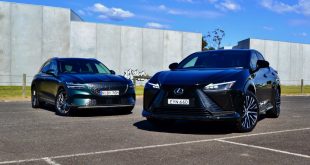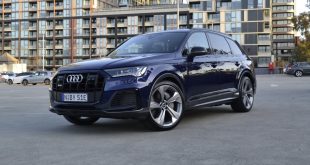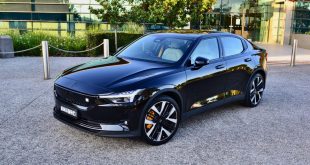‘RS’, ‘e-tron’ and ‘GT’, a very interesting combination of words in Audi sphere. RS tells me that this is an Audi with performance at its core, a car designed for fun driving, a no compromise driver’s car. E-tron is the name Audi gives to its electrified range of models. And lastly, GT stands for grand touring, a term used to describe a car built for open-road travel, one that can eat up the miles in speed, comfort and style.
Reading those words as a whole, the name Audi RS e-tron GT can be interpreted as an ultra high performance fully electric grand tourer. Sounds like something that I have been wanting to drive for a long time. And I have the keys to one. Do I need a better reason to go for a drive?
It’s a sunny day in late spring, with mild summary weather and long daylight. I pointed the RS e-tron GT towards Victoria’s Bass Coast, just about two hours drive out of Melbourne. Here, long open straights cut across the vast plains, joined later by sweeping bends and switchbacks that pass through sections of rolling hills, before unwinding onto the shores that overlook the Bass Strait. Perfect route to test a grand tourer like the RS e-tron GT.
With the demise of the Audi R8, the RS e-tron GT is now the flag bearer of the brand. Being an electric car, the RS e-tron GT can’t be more different to the scintillating V10 powered R8. The former is a practical four-door GT while the latter is a 2-seater supercar. There’s a big gap in pricing, too, with the R8 asking $400,000 and the RS e-tron GT costing ‘just’ $250,000. I supposed a fuel-guzzling, carbon-emitting supercar wouldn’t be a good image for a brand in transition toward 100 percent electric. The RS e-tron GT would have to do it for now, until a new Audi electric supercar arrives, if ever.
While many petrol heads, myself included, still drool over engine driven sports cars that make a lot of noise, the fact is that they will very soon be a thing of the past. Octane will be replaced by electrons and petrol heads will become electric heads (?!). The RS e-tron GT is incredible on paper. Its dual electric motors – one at each axle – produce a combined output of 440kW and 830Nm, the former can be raised to 475kW for a short while via a launch control boost mode. Even weighing nearly 2.5 tonnes, the RS e-tron GT is capable of dashing from zero to 100km/h in just 3.3 seconds, only 0.1 second slower than the much lighter R8. This is physics defying stuff.
It is literally. Such savage is the acceleration that your whole body is pushed into the seat and your head is pinned against the headrest. It’s a sensation that you get every time you squeeze the right pedal, one that you’ll never get bored off. The magic lies in the way electric motor delivers its torque, which is instantaneous. And with over 800Nm dropping onto the axles the moment you put your foot down, only a handful of supercars stand a chance against the RS e-tron GT at the lights.
To retain the theatrics you get when prodding an ICE sports car, the RS e-tron GT plays a synthesised note through the speaker under heavy acceleration. It’s nothing like the sound of a proper engine and you can’t turn it off. I supposed this is the sound of the future, as odd as it sounds.
Having covered 80 or so kilometres of freeway as I made my way out of Melbourne metro, it’s apparent that the ‘GT’ part of the RS e-tron GT name aren’t just two alphabets. I am driving a very fine long distance cruiser. The cabin is quiet, of course being an EV. The thickly bolstered front seats are sumptuously comfortable and supportive, so are the rear outboard seats which also come with bolsters for extra support. The earlier suburban driving has also showcased the car’s sublime ride quality, which isn’t expected for an air suspension setup shod with huge 21-inch wheels and low profile tyres. Just one thing though, the clear glass roof may look cool but let in too much heat on hot sunny days.
The relaxing cruise out of town also gave me chance to evaluate the car’s cabin design and tinker with its many technologies and features. The modern interior is a feast of carbon fibre panels, piano black trim inserts, suede lining and leather upholstery. It certainly feels like a very expensive car, except for the air vents which look a bit generic, like the stuff you get in a much cheaper Audi A1. There’s a reason why the RS e-tron GT interior is not allowed to have top shelf stuff from top to bottom. If it does it’d be as nice as the Porsche Taycan Turbo, a car that shares much of what’s under the skin with the Audi. The Taycan Turbo costs $294,000 by the way, with most of the premium paying for the badge and nicer cabin.
The tech is the typical Audi fair of digital everything, with the super high clarity 12.3-inch digital instrument display and 10.1-inch infotainment touchscreen being the main highlights. The systems, interface and navigation are similar to those found in regular Audi models, which make them very easy to use. But you could also argue that for a $250k car it’s not unreasonable to expect something a bit more special and bespoke? After all, this is the brand’s performance halo.
Essentials like DAB+ digital radio, sat-nav and support for Apple CarPlay (wireless) and Android Auto (wired) are all featured, so is the amazing 16-speaker Bang & Olufsen 3D Premium sound system. The front seats are heated and ventilated with massaging functions (the latter part of the $8400 Sensory Package option). Heating is also featured for the rear outboard seats ($950 option).
A swift exit from the M1 at Warragul signalled the end of my freeway run and the start of some more interesting roads. It’s time to let loose the RS e-tron GT. With the driving mode and adaptive dampers in the sportiest settings, I had a first taste of the car’s dynamics through the first series of corners. It’s taut with very little body roll. Granted, it’s no lightweight sports car and the heft is felt through tighter bends but it’s uncanny how composed and agile it is still.
With confidence gained, I pushed a little harder through the next sweeper, braked a little later at the following hair pin and got on the power a little earlier after the apex. The RS e-tron GT continued to hold flat and controlled, staying neat and tidy through these awesome driving roads. I figured much of the handling prowess comes down to these expertly tuned dampers and the Quattro all-wheel drive system. Instead of letting the weight rip the car off its driving line, the chassis exploits the weight and uses it to push the car down to generate high levels of grip. Quattro, with its electronic torque vectoring system then sorts out the power transfer to optimise traction further.
It’s certainly a very capable grand tourer, a supremely comfortable one as well. The steering is precise and the brakes are progressive, not typical of EVs. But the driving experience feels very weird without one important element – engine sound. It’s the bridge between driver and car, and the lack of it means there’s little engagement. At least not until petrol heads rewire their brains.
Pulling over at a lookout to appreciate the beautiful landscapes of Gippsland, I had the opportunity to admire the design of the RS e-tron GT. The first thing that hit me was how wide, sleek and hunkered down the car is. There’re many aerodynamic elements at play here, including the active cooling air inlets in the lower front bumper which only open when necessary, the active rear spoiler concealed neatly in the rear deck when not deployed and the completely flat underbody. All these are designed to smooth out airflow around and under the vehicle, ensuring a clean breakaway at the rear for minimum turbulence. The result is a super low drag coefficient of just 0.24. In other words the RS e-tron GT cuts through air like a bullet, giving more range.
The front fascia of the car is a little bland, bearing some resemblance of the Audi A6, but the rear is taut and purposeful. At night the taillights initiate a playful light show the moment the car is unlocked, it’s such a cool thing to watch and never ceases to grab the attention of anyone around.
The wheels are huge. They’re wrapped in 265/35 R21 rubber at the front and 305/30 R21 in the rear. They fill up the large wheel arches nicely. Peeking from behind the wheels are red painted brake callipers, a detail exclusive to RS-badged Audis.
With only 70km of range left, it’s now time to find an electric charging station, or I’m not going to make it home. The built-in navigation shows where the nearest charge points are and fortunately a 50kW fast charger shows up 20km away in Cape Paterson.
Range anxiety is still a problem with EVs, at least in country Australia where charge points are still far and few in between. Even when you get to one, there’s the wait time for the car to charge up. With the 50kW charger that I was using, it still took an hour to top up 200km of range. The car is rated for a maximum charge rate of 270kW, which can replenish the battery from 10% to 80% in 43 minutes, but there’re so few of these chargers around.
With the RS e-tron GT sufficiently charged for the return trip, I cruised home. It was also a good time to sum up my thoughts about the car which you can read in the verdict.
Verdict
Design & Comfort
Performance & Handling
Quality
Economy
Equipment & Features
OUR SCORE
4.1/5
+ Plus
- Superb performance and dynamics
- Excellent ride comfort
- Four-door practicality
- Unique looks
– Minus
- Lack of driving engagement
- Tight rear headroom
- EV range anxiety
Overall
If the brief was to build a super fast, highly dynamic and zero emission grand tourer that one can use everyday, the Audi RS e-tron GT has it nailed fair and square. It’s an incredibe machine that showcases what a finely honed high performance EV platform is capable of. But the lack of noise, pops and crackles means the senses don’t get aroused as much as us enthusiasts would’ve hoped for. At the end of the day though, it’s the perfect EV for those with deep pockets who want to standout from the vanilla EV crowd.
2024 Audi RS e-tron GT Price and Specification
| Price (excluding on-roads): | From $251,000 As Tested: $260,350 Included options: Sensory Package ($8,400) Heated rear seats ($950): |
| Warranty: | 5 years/unlimited km |
| Country of Origin: | Germany |
| Service Intervals: | 24 months/30,000km |
| Power Unit: | Dual electric motor, 93kWh lithium ion battery: 440kW, 830Nm |
| Drivetrain: | All-wheel drive |
| Energy Consumption (kWh/100km): | Claimed: 20.2 / Tested: 20.6 |
| Range (WLTP) | 433km |
| 0-100km/h (s) | 3.3 |
| Body: | 5 door liftback, 5 seats |
| Safety: | 8 airbags, reverse camera, surround view, forward collision mitigation, rear cross traffic alert, blind spot monitoring, front and rear parking sensors, DSC, TCS, ABS, EBD, EBA |
| Dimensions (L/W/H/W-B) mm: | 4,989 / 2,158 / 1,401 / 2,900 |
| Kerb Weight (kg): | 2,422 |
| Entertainment: | 10.1-inch MMI infotainment system, Audi Virtual Cockpit, Bluetooth, USB, smartphone interface, navigation, 16 speakers |
 ForceGT.com Car News, Car Reviews, Video Reviews, Tuning and much more.
ForceGT.com Car News, Car Reviews, Video Reviews, Tuning and much more. 








































